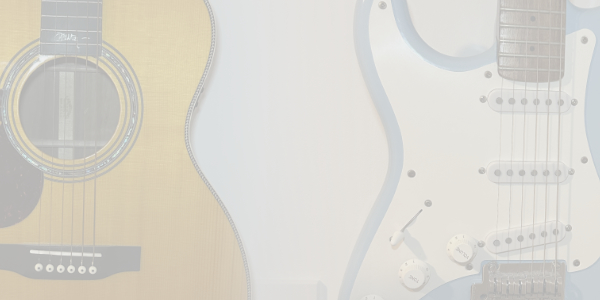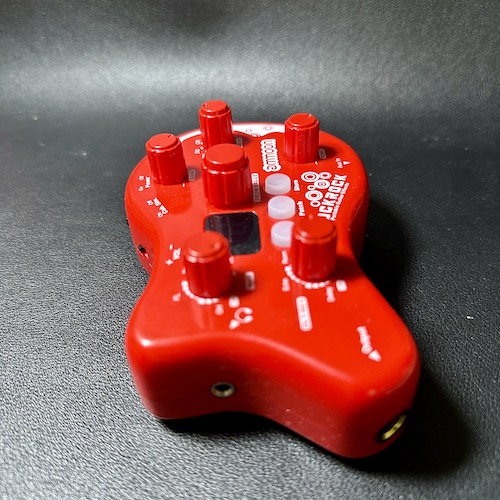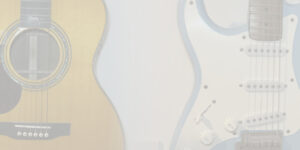
Ammoon Pockrock Review – Could this be the PERFECT £20 practice amp?
Introduction
Are you in search of a simple yet super affordable practice amp? Maybe even something you could throw into your gig bag and use as a backup amp? Well, today we are looking at the Ammoon PockRock.
The Ammoon PockRock is a small guitar multi-effect processor. Just by looking at it, you can see where it gets its inspiration from! With various effects and amp types, this device shapes up to pack a punch for its price. However, is it any good? Is it usable? Can you even get good sounds out of it? Let’s find out!
Ammoon PockRock

The Ammoon PockRock is a portable guitar effects processor and amp simulator. A lightweight device that has several amp options with various effects. It comes in a small package with various inputs, outputs, and controls. The PockRock is designed to be a clip-on guitar setup, allowing for simple and easy guitar playing.
So, why don’t we run through the controls and see what you can do with the PockRock? The device has a load of controls, lots to go through! Starting on the top right, we have the “Modulation” controls. Using this knob allows you to pick from one of four modulation effects (Chorus, Flanger, Phaser, and Tremolo), and of course, the option to switch them off. Between each effect, you can control how much of that effect you want. The knob below this is the Delay/Reverb control. Giving you the option for 4 effects (Delay, Echo, Room, and Hall), turning the knob will allow you to adjust how much of that effect you get until you click over to the next one.
Ammoon PockRock Continued
We have three buttons in the middle of the device: “Play,” “Patch,” and “Store.” The play button will start and stop the metronome, the patch button will select the preset list then you can use the select knob to cycle through, and finally, the store button will let you store any patches you have created to the select patch slot. To the left of these three buttons, we have the “Select knob”. This is where you control the menu and the patches. If you click and hold it in, you will activate the built-in Tuner.
On the top right, we have the Gain control. This allows you to adjust the gain for the chosen “Drive Channel” you have selected. Below this, we have the knob to control the drive channel. The drive knob lets you select between 6 “gain types” or you could say 6 “amp types”. These are Clean, Overdrive, Distortion, Crunch, Fuzz, and Metal. Below that, we then have the tone control which, as you would expect, controls the overall tone over the sound.
Around the outside of the PockRock, we have a few switches and options. We have the main output, for running into an interface or sound desk, then we have the volume, this controls the output volume for the device. You also get a switch to turn the cab sim on and off (more on this shortly). You have a main power switch to turn the device on and off. Along with that, we have a DC In, which you can plug the included wall wart into to power the device (the PockRock also runs on batteries). Finally, we have the Guitar input! This is, of course, where you plug your guitar into.
I purchased mine for £28.79 delivered to my door. This included the power supply. I mention this because there is an option to get it without the power supply.
The Sounds
For sounds, we wanted to demo each “amp type” that this comes with. So we created a little demo song for each one and tried them out. All effects you might hear are from the PockRock; however, I did turn the cab sim off for the demo songs and use the Two Notes software to “run it through” a 4X12.
After the demo songs, we will run through the device and the option and just spend a few minutes creating sounds. Showing what the device can do and sounds you can create. In this section, we use both the built-in Cab Sim and an external cab sim. We also run a few pedals through the device to show how it copes with pedals.
What are my thoughts?
The first thing you will notice is that it is light! Very light! I couldn’t tell you if this is a good thing or a bad thing, but it is very light! It doesn’t necessarily feel cheap, but it doesn’t feel the most well-made, like dropping it “might” break it! You would always be worried about putting it down too hard or it falling off something! Purely based on build quality, Would I trust this to be my main “Amp” at a gig? No, would I have it in a back just in case? Of course!
Can you get good sounds from it? Kind of! The clean sound is really nice! Playing around with the gain and tone, and you are able to get some genuinely lovely clean sounds! Add a bit of built-in delay and run a chorus into the PockRock, and you have a nice clean sound (we will talk more about pedals shortly). I will also say that the modulation effects are pretty good! Of course, there are no controls (except amount) but for the price, I would say the modulation effects are very usable!

More Thoughts!
As you heard in the demo sound, the PockRock sounds so much better when you run it through a separate cab sim! Being so cheap, I would imagine they have the cheapest (and worst) cab Sim and IR possible, however, running it through my Two Notes software and putting it through some more professional IR’s massively improved the sound! Improved them to, I would argue, somewhat usable sounds! Would have been nice to have the option to load in your own IR’s!
Something to just quickly mention, The PockRock does seem to have a built-in noise gate, I can’t find a way to switch It off. However, it is fairly strong! It will cut your note and sound off before it is finished. You will be able to hear it during sections of the demo sounds.
Ammoon PockRock Continued
I know you must be dying to know, What are my favorite and what is my least favorite sounds on the PockRock? Well, by far my most favorite is the clean sound with chorus; I think is a very usable sound! However, I also do like the Overdrive sound once you got the tone dialed in. Also, the Metal sound was alright when put through a better Cab Sim. My least favorite? The Crunch sound! No matter what I did it just sounded honked and the sound was all Low and mid-range! Frankly, without a lot of work, it was very unusable!
Does the PockRock take pedals? Can you use it with your current rig? Well, yes and no. There are two things to consider. The first being the god-awful cab sim makes hitting it with any overdrive pedal sound like a bag of wasps. The other is that this device has insane clean headroom! If you hit it with a boost pedal expecting it to break up into an overdrive, it won’t! It will just get louder! Can be useful! But the sounds you might expect your pedal board to get might not!

So what is it good for? Well, Put some batteries in it and you can clip it on your Guitar strap with headphones and you have a fully “wireless” practice rig! Easy to reach around and adjust the settings! If you live somewhere where you can’t crank the volume or just have to be careful for volumes then this is the perfect solution, super affordable, can set it up so all you got to do is pick up your guitar and play! No plugging in, no setting up, or moving equipment. For this, the PockRock is just perfect!
The question I have thought is with all the different gear you can get is there a market for something like this? For example, I have my Tube Amp running through a Two-note, or my Revv D-20 with XLR output. You can also use Amp Sim plugins or traditional mic on a cab, is there a need for a small device like this? I would argue yes! Being able to whip out a small device in a hotel room, backstage, or on a bus or car journey and practice is perfect! Plus some people (like myself) love having physical knobs to control! I think there is a market and would love to see Ammoon put out a more premium version with better Cab Sims, more control on the effects, and overall better sounds!
Conclusion
So that is our review of the Ammoon PockRock! Now, do I expect people to go out and gig with this? No, of course not! Is it a fun device? Of course, but could you use it at a pinch? I think you could! My only issue is the cab sims are rubbish so you would have to run it into a Cab Sim device and then to a PA, making the rig a bit bigger!
For the price, it is useful to have around, throw some AAA’s in it and keep it to hand for quick practice and ideas! It’s also good to have for some extra textures when recording! Double up a guitar track with this and you will create some great sounds. I guess you could even run it through a Cab Sim pedal and use it for a simple and lightweight rehearsal rig! Would it sound amazing? Not at all, could you carry your whole rig in your guitar bag? Absolutely!
If you are after some more affordable options we have a range of affordable reviews, with more on their way! So check out the link below for those reviews! Also, be sure to follow us over on our YouTube and Instagram, it helps us out loads!
Affordable Gear Review Links:
Check out our other Articles here


One thought on “Ammoon Pockrock Review – Could this be the PERFECT £20 practice amp?”
Comments are closed.